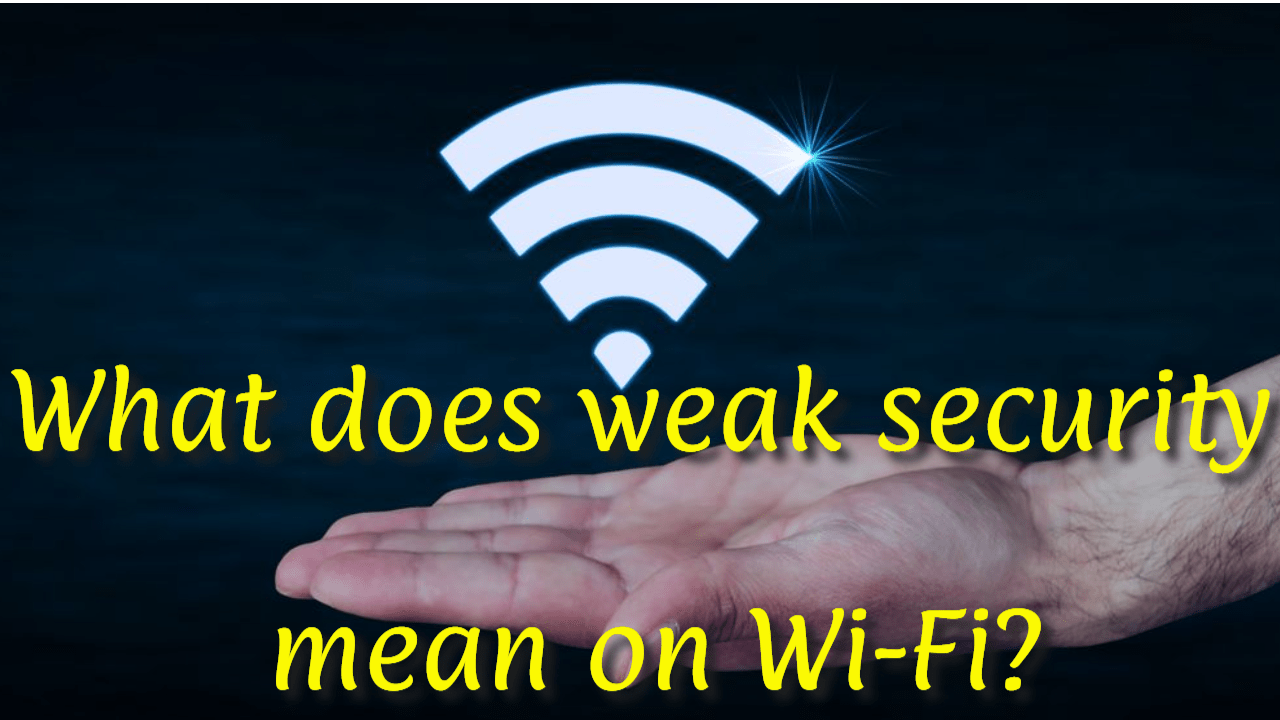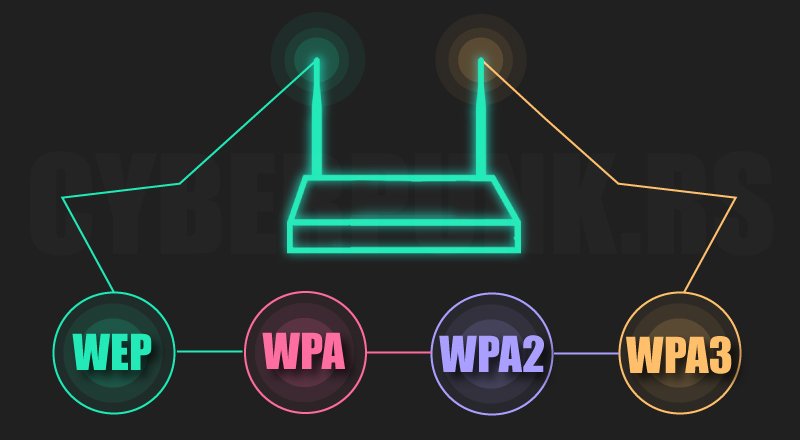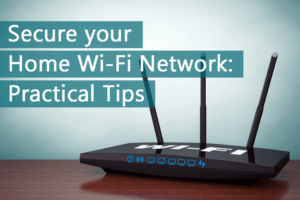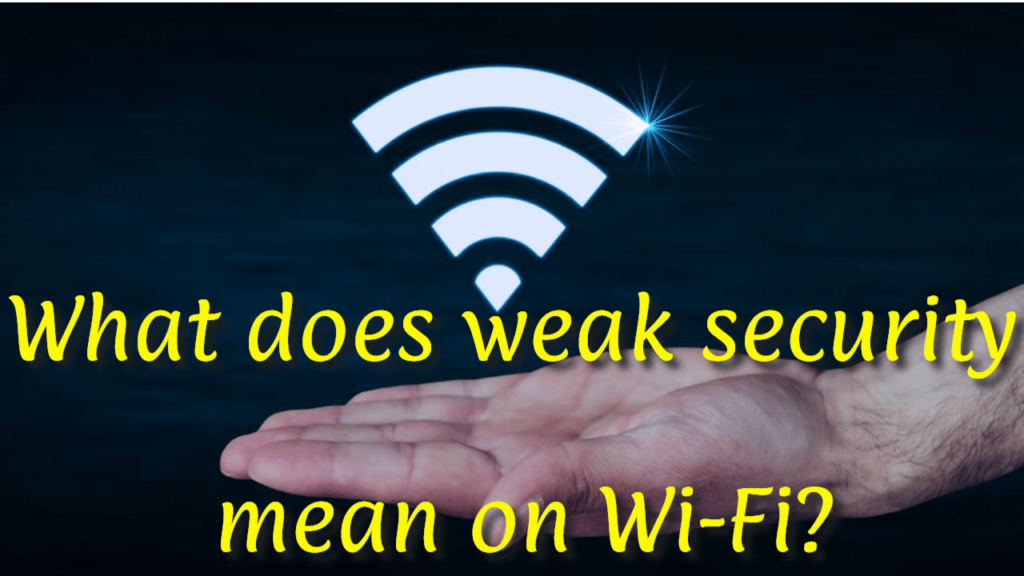What Does Weak Security Mean on Wi-Fi? – Let’s Review
‘What does poor Wi-Fi security imply?’ This Wi-Fi security notification should not cause fear, but it should draw your attention to the need for a remedy as quickly as feasible.
Because your phone or laptop detects that the Wi-Fi network is utilizing an outdated, “weaker” security protocol that is not totally safe, the word “weak security” appears on your Wi-Fi.
Wireless security safeguards our data and privacy by preventing unauthorized access to wireless devices. Because of a Wi-Fi router’s lack of security, malicious individuals on the internet can gain access to our privacy and data.
These people are skilled enough to break into our virtual world, which holds far more information than we keep in physical possession. They can gain access to any number of devices connected to a network with insufficient Wi-Fi security.
A weak password can easily be evaded or broken by an insufficient security standard. These thieves use critical software and equipment to gain internet access.
‘What does poor Wi-Fi security imply?’ – So, what is the relevance of this message in terms of certain gadgets, such as iPhones? The ability to detect incorrectly configured routers has been added to the most recent iOS 14 release.
As a result, many customers have reported seeing an iPhone notification indicating that their Wi-Fi is not secure owing to “poor security” while connecting to an older router with inadequate security.
Should you be concerned?
No, not always. The insufficient Wi-Fi security indicator indicates that the network to which you are connected does not use the most recent, completely secure protocols or passwords.
It does not imply that the network has been compromised or penetrated. In actuality, you can continue to use low-security Wi-Fi (the internet will continue to function), but it is not recommended due to apparent security issues.
Why is it so important to secure your wireless connection?
When choosing a Wi-Fi router, you most likely did not prioritize network security.
After all, most of us are more concerned with data transfer speeds and router range when it comes to home wireless internet.
However, now is the time to reconsider. Because a Wi-Fi station serves as a gateway for devices to connect to the internet, network security must be considered.
Nowadays, almost everyone owns at least one internet-connected device. As the number of these gadgets increases by the day, we must safeguard our wireless connections and tools to decrease the risk of privacy invasion.
‘What does weak Wi-Fi security mean for your network?’ – with relation to the topic, why is it critical to safeguard your Wi-Fi connection?
* Entities or data sharks frequently target these devices in order to obtain personal information. They steal identities and compromise personal and financial information in order to gain unobserved access to our data.
* Unauthorized individuals may get access to our devices and listen to, record, read, and transmit audio and video, as well as read, produce, and send communications.
* If your wireless network is not secure, you are at grave risk. Intruders have the ability to intercept any data you send or receive, see your files, gain unauthorized access to your internet connection, and drain your bandwidth.
As a result, whenever you think about ‘what does weak security mean on W-iFi,’ keep in mind that the concerns outlined above may occur with weak security Wi-Fi.
This type of activity can be avoided by establishing a higher level of protection and making a few changes to your router setup.
What is the security level of my Wi-Fi?
So, now that we’ve covered ‘what does inadequate security on Wi-Fi entail,’ it’s vital to question, ‘what security type is my Wi-Fi?’

To address poor Wi-Fi security, four distinct Wi-Fi encryption systems have been developed: WEP, WPA, WPA2, and WPA3.
* WEP, which stood for Wired Equivalent Privacy, was the first security protocol. WEP was originally used to offer data secrecy for wireless networks as part of the IEEE 802.11 standard protocol in 1997. It is the most basic and ineffective Wi-Fi encryption method known.
* WPA replaced WEP in 2003. WPA is an acronym for Wi-Fi Protected Access, and it was created as an interim standard when WEP was deprecated and in preparation for the more secure WPA2.
* In 2004, Wi-Fi Protected Access II (WPA2) was adopted, which includes essential components of the IEEE 802.11i standard. WPA2 outperforms WPA by upgrading the latter’s authentication and encryption capabilities. It’s common in current Wi-Fi encryption.
* In 2018, WPA3 (Wi-Fi Protected Access III) was launched to address WPA2’s weaknesses and vulnerabilities, such as its vulnerability to brute-force and key reinstallation attacks (KRACK).
WPA3 is the most recent Wi-Fi encryption protocol. It also has Easy Connect capability for IoT devices.
This latest security update will not only improve the security of Wi-Fi connections, but it will also protect you from security dangers posed by you.
Begin by considering how WPA3 will protect you at home. It will considerably mitigate the harm caused by your poor password choices.
WPA2 has a critical flaw: hackers can guess your password via an offline dictionary attack.
An attacker may guess your password as many times as possible without being on the same network, quickly cycling through the dictionary.
A new key exchange approach in WPA3 will protect against dictionary attacks.
The other benefit comes in the event that your password is still compromised.
WPA3 now enables forward secrecy, which means that any communication that had place previous to an outsider getting access is encrypted. They can even decrypt decommissioned WPA2 communications.
WPA3 is completely compatible with WPA2 devices to enable greater use.
However, it should be noted that the WP3 protocol can only be used with routers manufactured in 2019 or after.
How Do I Determine Which Security Type I’m Using?
You may be able to determine the security type by using your mobile device’s Wi-Fi settings. To ascertain the type of encryption:
1. Launch the Settings app on your mobile device.
2. Navigate to the Wi-Fi connection settings.
3. Locate your wireless network on the network list.
4. Click the network name or the information button to inspect the network configuration.
5. Examine the network configuration to establish the security level.
If the security type of your mobile device is not mentioned, you may be able to detect it by adjusting the settings on your wireless router.
Step 1: Access the router’s settings.

Because different Wi-Fi devices have different setups, the method you use to access your router settings is determined by the brand and manufacturer of your device.
The majority of routers have an IP address of 192.168.0.1 or 192.168.1.1. You may get to your router’s settings page by entering the IP address into the hostname field of your browser. You may also get to the settings page by typing the hostname into your browser’s address bar (for example, tplinkwifi.net).
Step 2: Look for security alternatives.
This varies by router, so look for the Wireless Security option. Look for terms such as encryption or security.
Change the security standard in step three (if Needed)
Once you’ve found the security options, choose WPA2 (AES) or WPA3 (AES) as your security standard; make sure to select “WPA2 alone” rather than “WPA/WPA2.”
Depending on your router, you may need to select “WPA/WPA2” first, then WPA2 from a second menu.
Don’t be concerned if WPA3 isn’t listed as an option; many Wi-Fi routers do not support it. If your router supports WPA3, select “WPA3/WPA2-Personal” to ensure that your devices may connect to your Wi-Fi.
Step 4: Implement the modifications.
Finally, depending on the choice on your router’s settings page, “Save” or “Apply” the changes.
‘What does poor Wi-Fi security imply?’ You now understand how to improve the security of your Wi-Fi network. You can make your Wi-Fi more secure with a few simple steps.
Recommendations for Wi-Fi Security
Almost every member of the household uses a laptop, PC, smartphone, or tablet to access the internet.
A simple weakness in your Wi-Fi network can allow hackers access to almost all Wi-Fi devices. Access could cause issues with bank accounts, credit card information, child safety, and other sensitive information.
The tips below are intended to assist you in protecting your Wi-Fi network from unauthorized access.
1. Change your wireless network’s name.
The first step in wireless network security is to alter the SSID (service set identifier). A network is identified by its SSID.
Many manufacturers assign a default SSID to all of their wireless routers. In most cases, it is the firm’s name.
When a wirelessly connected computer searches for and shows surrounding wireless networks, the SSID of each network that broadcasts is publicly recognized.
This increases the chances of a hacker breaking into your network.
To prevent hackers from endangering your wireless security, change the network’s SSID to something that does not reveal any personal information.
2. Restrictions on network access
Did you know you may block specific devices from using your Wi-Fi?
You can allow or ban specific devices from connecting to your Wi-Fi network.
Every smartphone, tablet, laptop, desktop, and printer is assigned a Media Access Control (MAC) address, which is a unique identifying number.
From your router’s homepage, you can examine, filter, and deny or accept the connection.
3. Modify the default passwords.
To make configuration easier, most network equipment, including wireless access points, comes with pre-configured default administrator passwords. Default passwords offer little protection because they are commonly available online.
Making it more difficult for attackers to guess default passwords makes it more difficult for them to gain access to a device. The first line of defense for the security of your device is to use and frequently change difficult passwords.
4. Use the most recent WPA network encryption.
As we discussed in the last section, there are various methods of Wi-Fi security that you can employ for your network. Please make it a practice to always utilize the most recent version.
If your router only offers Wired Equivalent Privacy (WEP) security, it should be replaced because it is most likely out of date in other ways.
WPA is sufficient; WPA2 is substantially superior and may be the most recent version that most routers can support today, and it is suitable. Although WPA3 is the most recent version available, not all routers support it. If at all possible, make the switch to strengthen your Wi-Fi security.
As noted in the last section, you may modify your Wi-Fi encryption under the router settings, which is also where you can change your password.
5. Ensure that your router is up to date.
Check the manufacturer’s website before installing a new router or upgrading an old one to see if a more recent version of the software is available for download.

Sign up for updates and register your router with the manufacturer to ensure you get the most recent version. If you purchased your router through an Internet Service Provider (ISP) such as Verizon or Comcast, inquire about automatic upgrades.
6. Create a guest network.
Most routers allow you to set up a separate guest network with its own name and password. It is a good security precaution for two reasons:
1. Having a second login ensures that fewer individuals know your primary Wi-Fi network password.
2. If a visitor unintentionally has malware on their phone or tablet, it will not enter your primary network or your devices.
7. Make sure you have a strong firewall.
A “firewall” is a piece of software that protects computers from hostile intrusions.
Wireless routers typically feature built-in firewalls; nevertheless, the firewall is frequently disabled. Make that the wireless router’s firewall is turned on.
Install a dependable firewall solution on your device to monitor for illegal access and increase your wireless security if your router lacks a firewall.
8. Always keep commercial-grade antivirus software on hand.
Install and update your virus definitions. with high-quality antivirus software Many antivirus programs now integrate spyware and adware detection and protection tools.
My recommended antivirus software is Sophos Home Premium, created by Sophos Limited, a British business specializing in digital security.
Sophos Home Premium employs the same advanced artificial intelligence used in commercial antivirus security solutions for large companies facing regular ransomware threats to monitor application activity on your home computer network.
Sophos now offers the same level of security for personal computers as it does for around 300 million commercial devices worldwide.
Visit this website to discover more about Sopho’s commercial-grade antivirus protection for your home.
9. When utilizing mobile devices, use the utmost caution.
Some mobile apps may have the ability to connect to your home network.
A mobile hotspot on your smartphone, for example, appears to be secure, but don’t forget to turn off the network remotely afterwards. The use of a mobile device needs the use of a password.
Use a password that is at least 20 characters long and contains both alphanumeric and symbol characters.
Also, log out whenever you’ve finished using the app. Also, ensure that your phone has a strong password. or enabled multi-factor authentication (MFA). This safeguard prevents the phone and app from being abused.
Use a Virtual Private Network (VPN) (VPN)
A VPN functions as a protection to protect your online activities. Installing a VPN on all of your internet-capable devices allows you to safely browse the internet when at home or on the go.
Depending on where you are, Wi-Fi may be available in coffee shops, restaurants, clubs, and school campuses.
The level of security on these networks cannot be determined.
A man-in-the-middle attack, which occurs when an attacker intercepts data on an unprotected network, could be used to eavesdrop on your connection and steal your data.
These assaults pose a major risk to people who work from home. Statistics show that 80 percent of remote workers work primarily from home, with 27 percent working from a coffee shop as a secondary location.
The fundamental function of a VPN is to encrypt your connection, allowing you to safely browse the internet even when utilizing public hotspots.
At this point, you should have a firm grasp on ‘what does weak security on Wi-Fi mean?’ It is a Wi-Fi connection issue that may risk your security.
The Wi-Fi router has the ability to divert network traffic. It also keeps track of all of your gadgets, including tablets and laptop computers.
Anyone who gains access has complete control over all of your devices and data. Weak Wi-Fi security is the entry point for such devices to be hacked.
As a result, protecting your router is critical. The ideas and solutions outlined above are simple to adopt and will put an end to the nagging question, “What does weak security on Wi-Fi mean?”
Our Favorite VPN Service Provider
A reliable VPN service establishes a secure, encrypted tunnel through which online traffic can pass. Nobody can see through the tunnel, read your online data, or discover your IP address and location.
If you want to feel safe when utilizing public Wi-Fi, NordVPN is the best VPN to use. Securely access personal or professional data, encrypt your internet connection, and conceal your browsing history and online identity.
Do you want to protect all of your devices?
Do you use Windows at work, Mac OS at home, and Linux on a regular basis? You will have internet privacy and security on all platforms.
NordVPN also has apps for Windows, macOS, iOS, Android, Linux, and Android TV. Chrome, Firefox, and Edge all have encrypted proxy plugins.
The best feature is that you may encrypt up to six devices simultaneously with a single NordVPN subscription. With 14 million customers globally, it is the greatest VPN provider for all of your devices.
Do you want to be able to connect to the internet quickly and reliably from any location?
Because buffering is the ultimate buzzkill, using a slow internet connection to broadcast or download anything is out.
There’s no need to be concerned; what sets NordVPN apart from other VPNs is its unequaled combination of impenetrable security, lightning-fast connection speed, and limitless capacity.
Choose from over 5400 NordVPN servers in 60 countries to enjoy the fastest VPN experience available anywhere in the world, from the UK to Australia or Canada.
Do you want to stay away from advertisements, trackers, and malware?
NordVPN’s newest feature, Threat Protection, takes your cybersecurity to the next level.
It does not require a VPN server connection to function. If you enable Threat Protection in the settings, your browsing will be safer and more enjoyable eternally.
Don’t worry about accessing a malicious website, downloading malware, or dealing with trackers and irritating adverts. Threat Protection will detect and destroy cyber threats before they cause serious harm to your device or data.
Click here for more information about NordVPN, our top choice, including its award-winning features and security and its 30-day money-back guarantee.
The Post: What does weak security mean on Wi-Fi? was first seen on https://websecurityhome.com
This Post is Brought to You By:
The post What Does Weak Security Mean on Wi-Fi? appeared first on https://cable13.com
The post What Does Weak Security Mean on Wi-Fi? appeared first on https://gqcentral.co.uk



